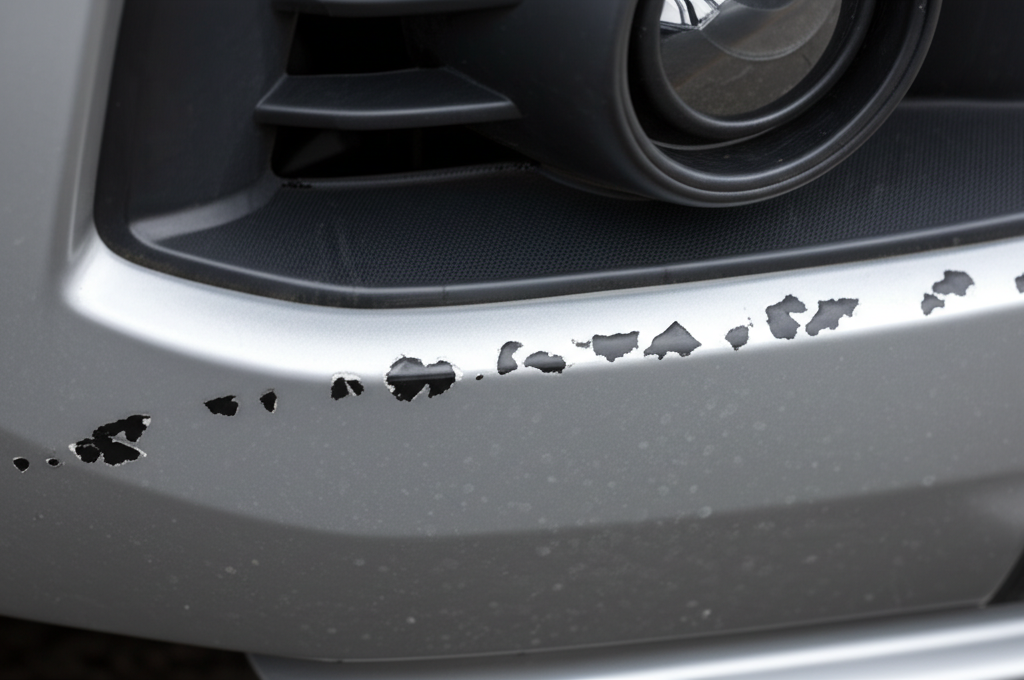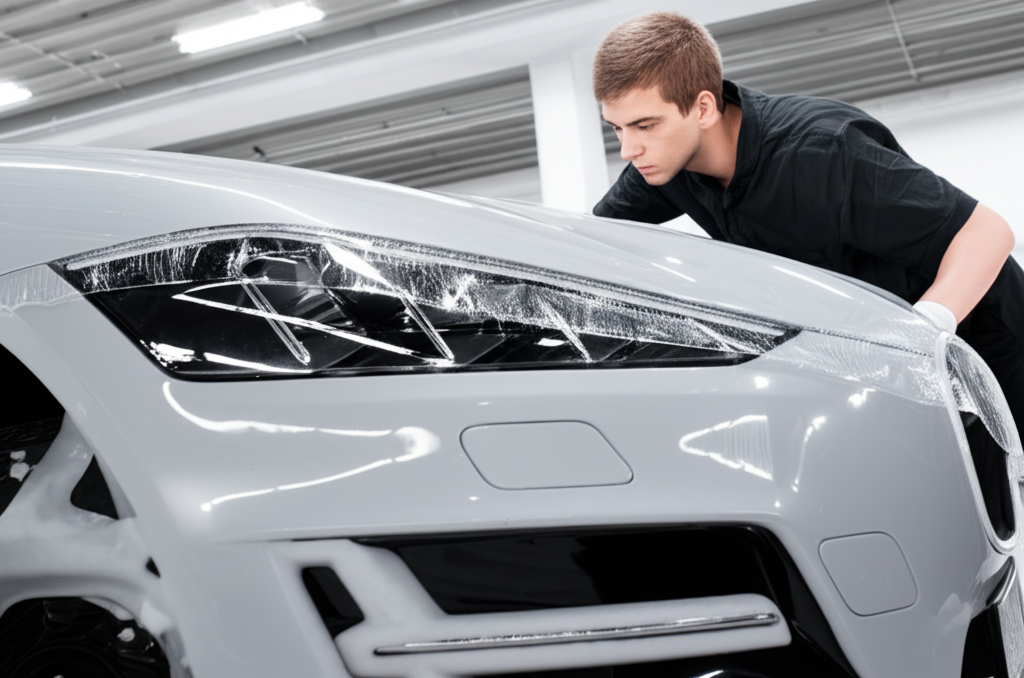Picture this: you’re cruising down the highway, perhaps heading from Bangkok to a crucial meeting in Chonburi or navigating the scenic routes towards Chiang Mai for a week-long business trip. Your vehicle, often a mobile office and a symbol of your professionalism, glides smoothly. Suddenly, you hear it – that sharp, sickening ‘ping’ against the front of your car. Your heart sinks slightly. You know exactly what that sound means: another stone, kicked up by a truck or loose from the road surface, has likely left its mark. For business owners who spend countless hours on Thailand’s extensive road network, this isn’t just an occasional annoyance; it’s a recurring frustration that degrades the appearance and value of a vital business asset. The pristine look fades, replaced by a constellation of tiny paint chips, especially on the vulnerable front bumper and hood. It begs the question: Is there a truly effective way to shield your vehicle from this relentless onslaught? Many talk about Paint Protection Film (PPF), but does it actually stand up to the harsh reality of high-speed highway driving and flying debris?

Let’s delve into whether this ‘invisible shield’ is just marketing hype or a genuine solution for the road-weary business vehicle.
Meet Mr. Tanawat: A Case Study in Highway Protection
Mr. Tanawat runs a successful distribution business that requires him to travel extensively by car between his base in Bangkok and regional hubs like Khon Kaen and Surat Thani multiple times a month. His Toyota Alphard, less than a year old, serves as both transport and a statement of his company’s reliability. However, the frequent highway journeys were taking a visible toll. “I was washing the car after a trip up North,” Mr. Tanawat recalls, “and I was just dismayed. The front bumper looked like it had been sandblasted. There were dozens of small white spots where the paint had chipped off completely. It looked unprofessional, and the thought of repainting so soon was infuriating.”
Frustrated with constant touch-ups and worried about long-term damage and rust, Mr. Tanawat started researching protective solutions. He’d heard about ceramic coatings but understood they primarily offered gloss and chemical resistance, not significant impact protection. His research led him to high-quality Paint Protection Film (PPF). Initially sceptical about the cost and effectiveness, he decided to invest in protecting the high-impact areas of his Alphard: the full front bumper, the entire hood, front fenders, and side mirrors.
The installation process took professionals about two days. They meticulously cleaned and prepped the paint surface before carefully applying the transparent, self-healing film. The change wasn’t just about protection; the high-quality PPF added a noticeable depth and gloss to the paint, making the vehicle look even newer. More importantly, Mr. Tanawat embarked on his subsequent highway trips with a newfound sense of ease. Several months and thousands of kilometres later, the difference is stark. “I still hear stones hitting the front occasionally,” he admits, “but now, when I inspect the car, there’s nothing. Maybe a tiny mark on the film itself, which often disappears later thanks to the self-healing, but the paint underneath remains perfect. It’s peace of mind I didn’t have before. My vehicle still looks impeccable, reflecting well on my business during client visits.”

Understanding Paint Protection Film (PPF): More Than Just a Sticker
So, what exactly is this PPF that shielded Mr. Tanawat’s Alphard? Paint Protection Film is typically a transparent or coloured thermoplastic urethane (TPU) film applied to the painted surfaces of a new or used car. Unlike thinner vinyl wraps primarily for colour change or basic ceramic coatings for gloss and water repellency, PPF is engineered specifically for impact resistance.
Its primary function is to absorb the energy from small impacts – like stones, gravel, road debris, bug splatters, and minor scuffs – preventing them from chipping, scratching, or etching the underlying paintwork. Think of it as a sacrificial barrier. High-quality PPF also possesses other beneficial properties:
- Self-Healing: Minor scratches and swirl marks on the film’s top coat can often disappear with exposure to heat (sunlight, engine heat, or warm water).
- UV Resistance: Helps prevent the film itself from yellowing over time and protects the underlying paint from UV damage and fading, crucial under the strong Thai sun.
- Stain Resistance: Resists staining from bug guts, bird droppings, tree sap, and road tar.
- Hydrophobicity: Many modern PPFs have water-repellent properties, making the car easier to clean.
- Optical Clarity: High-quality films are virtually invisible once applied correctly, preserving the original paint colour and finish. Some even enhance gloss.
But how does PPF stack up against other options frequently considered by car owners?
PPF vs. Alternatives: A Comparative Look
| Feature | Paint Protection Film (PPF) | Ceramic Coating | Wax / Sealant | Repainting (Affected Areas) |
|---|---|---|---|---|
| Primary Function | Impact & Scratch Protection | Chemical Resistance, Gloss, Hydrophobicity | Basic Protection, Gloss, Hydrophobicity | Restores Paint Appearance |
| Stone Chip Protection | Excellent (Designed to absorb impact) | Minimal / None | None | N/A (Repairs existing damage) |
| Scratch Resistance | Very Good (Self-healing for light scratches) | Good (Against micro-scratches/swirls) | Minimal | Same as original paint (vulnerable) |
| Material | Thermoplastic Urethane (TPU) | Liquid Polymer (SiO2/TiO2 based) | Natural Wax / Synthetic Polymer | Automotive Paint |
| Typical Lifespan (Thailand Climate) | 5 – 10+ Years (Quality dependent) | 1 – 5 Years (Product dependent) | Weeks – Months | N/A (Durability of factory paint) |
| Approximate Cost (Front End Coverage) | $$$ – $$$$ (Significant Investment) | $$ – $$$ | $ | $$ – $$$ (Per incident/area, potential colour mismatch) |
| Best Suited For | Maximum physical protection, frequent highway drivers, preserving new/valuable cars | Enhanced gloss, ease of cleaning, chemical protection | Basic gloss enhancement, budget-conscious owners | Repairing existing significant damage |
As the table illustrates, when the primary concern is protecting against physical impacts like stone chips – the exact problem faced by long-distance business drivers on highways – **PPF is unequivocally the superior solution.** While it represents a higher upfront investment, the cost of *not* having it can accumulate through repeated touch-ups, potential panel repaints (which may affect resale value due to non-factory paint), and the constant stress of potential damage.
Voices from the Road: Business Owners on PPF
Mr. Tanawat isn’t alone in his experience. Here’s what other business drivers in Thailand have shared:
“My black Mercedes is used daily for client meetings across Bangkok and nearby provinces. Before PPF, every highway trip meant anxiety about new chips on the hood. After getting a full front PPF package, that worry is gone. The car stays looking sharp, which is crucial for the image I need to project. The film is practically invisible.”
– Ms. Pim, Sales Director
“I drive a Ford Ranger for site visits, often on less-than-perfect roads outside the main cities. Gravel roads were murder on my previous truck’s paint. I had PPF installed on the front end and lower doors of my new Ranger right away. Six months in, it’s already saved me from countless potential chips and scratches. It feels like a necessary piece of equipment, not a luxury.”
– Mr. Chatchai, Construction Project Manager
“Initially, the price of PPF seemed high. But then I calculated how much I was spending on detailing to fix minor scratches and how much a bumper repaint would cost. Over the expected life of the film, PPF makes financial sense, especially considering it helps maintain the car’s resale value. Plus, the relief of not flinching at every pebble sound is priceless!”
– Mrs. Siriporn, Independent Consultant
The common thread is a shift from anxiety and frustration about inevitable paint damage to confidence and peace of mind. For busy professionals, reducing stress and protecting valuable assets are significant benefits.
Protect Your Investment, Protect Your Image
For business owners whose vehicles are essential tools and reflections of their success, maintaining a pristine appearance is paramount. Constant highway travel in Thailand presents a significant challenge to achieving this due to the prevalence of road debris and stone chips.
The evidence and real-world experiences confirm that high-quality Paint Protection Film is not just a viable option but arguably the *most effective* solution for preventing stone chip damage. It’s a proactive investment in preserving your vehicle’s aesthetics, protecting its value, and reducing the stress associated with long-distance driving.
If you frequently travel Thailand’s highways for business and are tired of seeing your vehicle’s front end suffer from ‘road rash,’ it’s time to seriously consider PPF. Protect your professional image and your automotive investment.
Ready to shield your vehicle from highway hazards? Contact us today to discuss the best PPF options for your business car or fleet.
📱 Want to learn more about car wrap & paint protection?
Feel free to reach us on LINE:

🌐 Official Website: https://tpuwraps.com
Frequently Asked Questions (FAQ) about PPF
- Q: How long does PPF installation typically take?
- A: Depending on the coverage chosen (e.g., front end only vs. full car), installation usually takes 1 to 3 days. This includes thorough cleaning, preparation, precise film application, and curing time.
- Q: Will PPF change the look of my car’s paint?
- A: High-quality PPF is designed to be optically clear and virtually invisible. It should not alter the colour of your paint. In fact, many premium films have gloss-enhancing properties that can make the paint look richer. Matte finish PPF is also available to protect factory matte paint or give a glossy car a satin look.
- Q: Can PPF be applied to an older car or only new cars?
- A: PPF can be applied to both new and used cars. However, for the best results on a used car, the paint should be in good condition. Professional installers will often recommend paint correction (polishing to remove swirls, scratches, and imperfections) before applying the film to ensure a flawless finish and proper adhesion.
- Q: How do I care for a car with PPF?
- A: Caring for PPF is relatively simple. You can wash the car as usual, preferably using the two-bucket method and a pH-neutral car shampoo. Avoid abrasive polishes or harsh chemicals directly on the film. Many PPF manufacturers offer specific aftercare products. Most high-quality films are also safe to use with ceramic coatings designed for PPF, enhancing hydrophobicity and ease of cleaning.
- Q: Will PPF yellow over time, especially in Thailand’s strong sunlight?
- A: This was a concern with older generations of PPF (often made from PVC). However, modern high-quality PPF is made from Thermoplastic Urethane (TPU) and includes UV inhibitors specifically designed to resist yellowing, cracking, and discoloration even in harsh sun conditions like those found in Thailand. Choosing a reputable brand and installer is key to longevity.
The Verdict: Is PPF Worth It for Highway Warriors?
Returning to our core question: Can Paint Protection Film truly stop stone chips encountered during high-speed highway driving? Based on the material’s properties, real-world tests, and the experiences of business owners like Mr. Tanawat, the answer is a resounding **yes**. While no solution can guarantee protection against absolutely every possible impact (like a large, sharp object hitting at extreme force), high-quality PPF provides outstanding resistance against the common stone chips and debris that plague highway drivers.
For the business owner who relies on their vehicle for frequent, long-distance travel across Thailand, PPF transitions from being a perceived luxury to a practical necessity. It safeguards the vehicle’s appearance, preserves its resale value, reduces the need for costly paint repairs, and provides invaluable peace of mind on the road. It allows you to focus on your business, not on the potential damage inflicted by the journey.
Don’t let highway debris dictate the condition of your professional vehicle. Invest in protection, drive with confidence.
